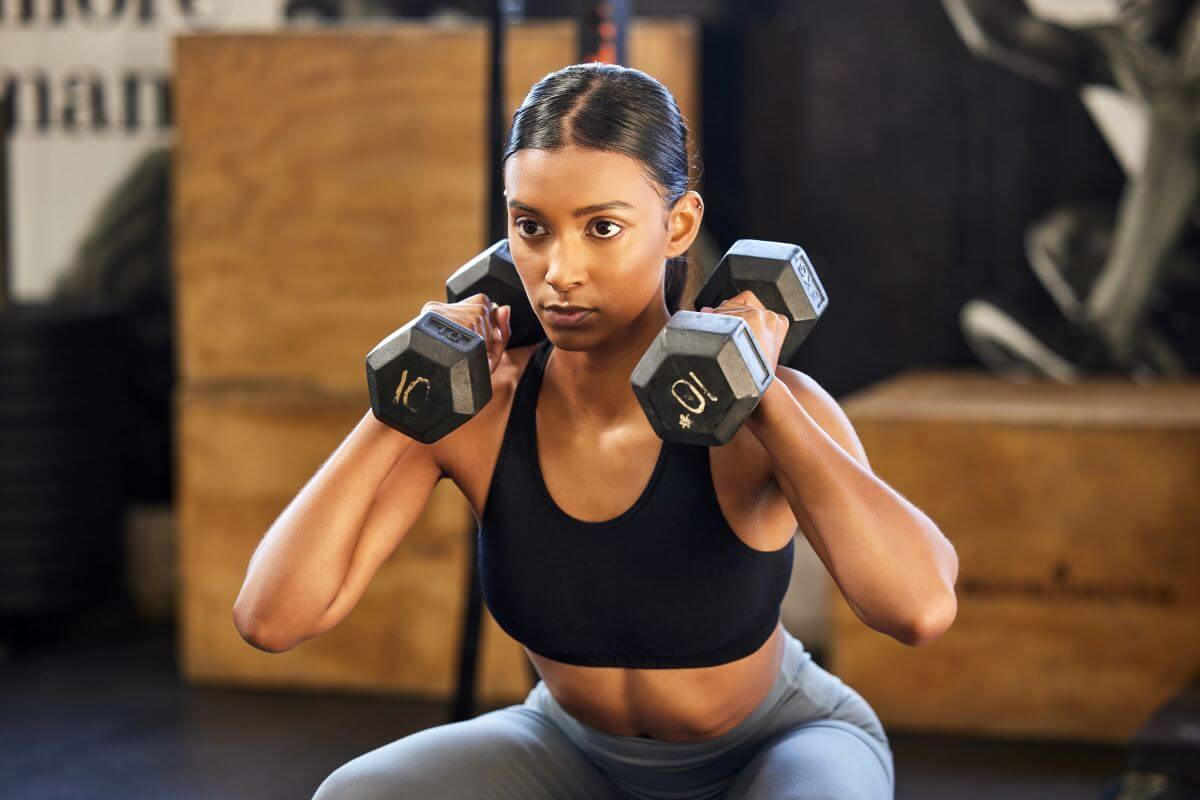The dumbbell squat is a forgotten exercise among recreational bodybuilders.
However, it is quite a popular exercise for fitness class instructors to provide their class with a challenging compound exercise for their clients.
The most common reason for performing a dumbbell squat? At-home workouts. Many people, me included, have a pair of dumbbells at home. If you want the best bang-for-your-buck piece of equipment for your home gym, simply purchase a set of adjustable dumbbells and you’ll instantly have a path to endless dumbbell exercises and progressive overload.
So, now that we’ve introduced the dumbbell squat, how do you perform it? What muscles does it target? How do you build your workouts around them? And are there any other variations?
I’ll be providing an answer to all of those questions in this complete exercise guide, so sit back and get ready to learn all about the dumbbell squat.
How to Perform the Dumbbell Squat
To perform dumbbell squats, you will need a set of dumbbells that provide you with a challenge to perform the squat movement pattern. It is a variation of the squat movement pattern. To perform dumbbell squats:
- Select the weight in which you can perform the exercise with safe and correct form.
- Place the weight on the floor in front of your body. (Think of keeping them within distance to perform a deadlift or clean).
- Assume a shoulder-width stance with your feet pointed at a slight outward angle.
- Grasp the set of dumbbells and clean them both into a front rack position even with your shoulders. Your palms should be in a neutral position facing in towards your body.
- Ensure that you are rooted to the floor through your feet. To do this, think of pressing through all four corners of the foot.
- Brace your core.
- Begin to descend into the squat by pushing your glutes back as though you are sitting in a chair. Continue to lower until you have reached a desired depth based on the anatomy of your body. Your core should remain engaged, and your back should be kept in a neutral position.
- Once you have reached the desired depth with your back remaining neutral, reverse the movement pattern by engaging the hips and driving them forward until you are back in the starting position.
- Repeat for the desired number of repetitions.
What Muscles Does the Dumbbell Squat Target?
The dumbbell squat is a compound exercise that works several muscles throughout the body.
In terms of direct impact, which is an important consideration when designing a workout routine, the exercise targets the muscles of the lower body. This includes the quads, glutes, hamstrings, and calves. It also greatly challenges your core muscles and lower back muscles.
Indirectly, you may feel tension in your shoulders and arms as you hold the weight up throughout the exercise. There may be some minor back and trap involvement as you clean the dumbbells into the front rack position as well.
All in all, the dumbbell squat, like any squat variation, is a big-time exercise taxing numerous muscle groups at once. This makes it the perfect exercise to build a workout around.
How to Add Dumbbell Squats to Your Workouts
So, how exactly does one build the dumbbell squat into their workout routine? Excellent question, and it may have a different answer for nearly every individual. This is because everyone has slightly different goals, levels of fitness, and access to fitness equipment.
Generally speaking tough, the dumbbell squat can be included in leg workouts for those who prefer bro split styles of training. The same can be said about its inclusion in push/pull/leg splits.
It is also an excellent movement pattern to include in lower body workouts as part of an upper/lower split.
It can be used in push workouts of push/pull splits.
Or it can be used in full body workouts or dumbbell only workouts.
All that to say, it is an extremely versatile movement to have in your rotation of leg exercises.
In terms of reps and sets, it will depend on how you program the exercise into your training. If you wish to treat it as a main movement of your workout, it will be placed as the first exercise of your training day with a range of 3-5 sets and anywhere between 6-12 repetitions.
If you want to treat it as an accessory lift, it will likely fall somewhere in the middle of your workout with 2-4 sets of 8-20 repetitions depending on your goals.
Dumbbell Squat Variations
The dumbbell squat is a variation of a squat itself. It tends to be more of a variation of a front squat than a back squat. That being said, there are plenty of other variations of this exercise that may fit your needs. Some of them include:
- Dumbbell Goblet Squat
- Dumbbell Plie Squat
- Dumbbell Wide Squat
- Dumbbell Narrow Squat
- Kettlebell Squat
- Resistance Band Squat
- Dumbbell Squat-to-Press
Conclusion
In this article, we covered a lot of information about dumbbell squats. The exercise can be used in several different ways. My personal favorite way to use the dumbbell squat is as a primary exercise in my dumbbell only workouts that I perform at home.
If you enjoyed this article, consider bookmarking Legacy Muscle to come back to. We are always publishing new exercise guides and workout routines. And please share us with your fitness friends!
